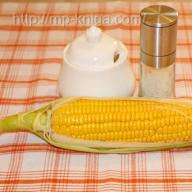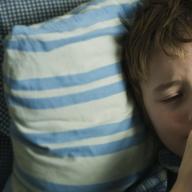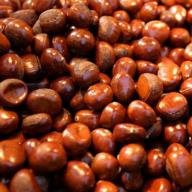Dear readers, today we will look at issues related to the hygiene of an infant’s nose. We will learn how to properly clean the nose, what products to use during this procedure, what not to do, and how to protect the baby’s health in advance.
Baby's nose
The nose of an infant is distinguished by the fact that it has narrow passages. Because of this, even a small accumulation of mucus can complicate the baby’s breathing. It will become difficult for him to breathe, he will have difficulty sleeping, and then this can lead to health problems.
Should I clean my baby's nose?
In the baby's nose, on the mucous membrane, there is ciliated epithelium, which helps remove mucus and dust particles. First, he moves them closer to the exit. Then local irritation and sneezing of the child occurs. Thanks to this, unnecessary particles and excess mucus are easily removed from the nose. That is, the self-cleaning of the spout was anatomically provided. Interferon is also formed in small quantities in the nasal passages, which serves as a local immune system and protects the body from the penetration of pathogenic microorganisms. If there is a lack of this protein, the child’s body becomes vulnerable.
However, when a child has an excess of mucus or, on the contrary, the nasal cavity dries out, you need to help the baby and clean the nasal passages.
Reasons for the formation of crusts
The crusts are dried mucus. This process occurs for two main reasons.
- The first is a disease that is accompanied by inflammation in the mucous membrane of the nose.
- The second reason is insufficient humidity in the room where the baby is located. Most often due to lack of ventilation in the room.
How to properly clean a child's nose
When taking care of the hygiene of your baby’s nose, you need to find out all the rules for carrying out this procedure, the procedure, what products can be used and what cannot be used, and precautions.
When and how often to perform the procedure
An important question is how often should you clean your child’s nose? The fact is that it all depends on the individual characteristics of your baby. You need to observe the baby and then you yourself will be able to understand how often this procedure is necessary for your child.
If the air in the room is dry enough, then the baby’s nose will need to be cleaned of crusts. If you notice that your baby begins to snore or has difficulty breathing during feeding, check to see if crusts have formed that are making breathing difficult.
During an illness, namely a runny nose, the nasal passages become swollen, an excess of mucus is produced and the child also finds it difficult to breathe. On days like these, cleaning your spout is vital.
When my baby has a runny nose, I have to clean his nose 3-4 times a day.
What to do when a child does not allow you to clean your nose? The only solution to this problem may be to entice the child. You can ask dad to sing a song and try to cheer up the baby. In general, so that all the baby’s attention is concentrated on something else and distracts him. This is the only way we can be saved. Although our baby is not always capricious during this procedure. I sympathize with mothers who have this problem constantly.
Procedure for cleaning the spout
- It is necessary to soften the crusts. To do this, you need to drip your nose with a self-prepared saline solution, saline solution or breast milk. To apply drops to the nose, place the baby on his back, tilt his head slightly back. It is better to do this while holding the baby in your arms. Place 1-2 drops into each nasal passage. The second way is to start the cleaning procedure after bathing, when the nose has steamed and the crusts themselves have begun to get wet.
- You need to fix the baby's head. Whatever means you use to carry out the cleaning procedure, you need to protect your baby from injury as a result of sudden head movements.
- 1-2 minutes after instillation, you can begin cleaning the nasal passages. Whatever product you choose, do not forget that you cannot penetrate too deeply into the baby’s nose.
What tools can be used
The easiest and most accessible remedy is cotton wool. You can either purchase them at the pharmacy or make them yourself. From my own experience, I can say that it is better to use hand-made flagella. To prepare them, we did not use cotton wool, but cotton pads. They took one such disk and tore it into four parts. Then one such particle was twisted to form a flagellum.
How to clean a newborn baby's nose with a flagellum? When you treat your nose in this way, you need to moisten the flagellum with warm boiled water or breast milk and clean it in a circular motion so that mucus or crusts can attach to it and be successfully removed from the nasal passages.
Another means for cleaning dry crusts from the nose is a pear, which you can purchase at any pharmacy. Just don’t forget to first drip breast milk or saline onto your baby’s nose to soften the crusts. 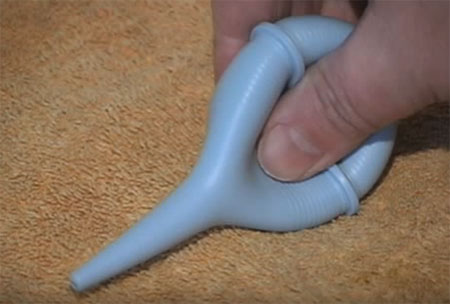
The pear must be squeezed to get rid of the air. Then gently insert it into your baby's nostril, but don't push it too deep. And unclench your hand, the boogers will be drawn into the pear. Then repeat the procedure with the baby’s second nostril. After each procedure, do not forget to wash the pear.
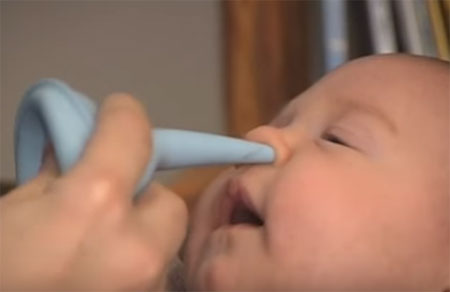
At the pharmacy you can purchase special nasal pumps - aspirators. This device consists of two tubes and a container. 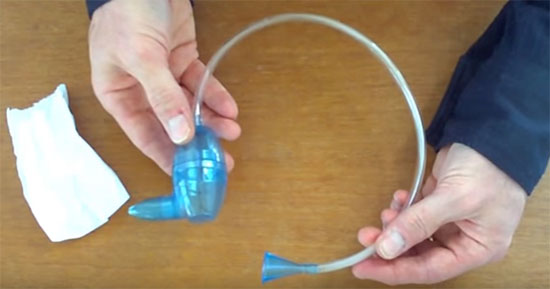
The method of its use is quite simple. First, lubricate the nose with baby oil or drip it with special drops. Then you need to insert one tube into the child’s nostril, and you must take the other into your mouth and draw in air. In this case, everything that has accumulated in the spout will end up in the container.
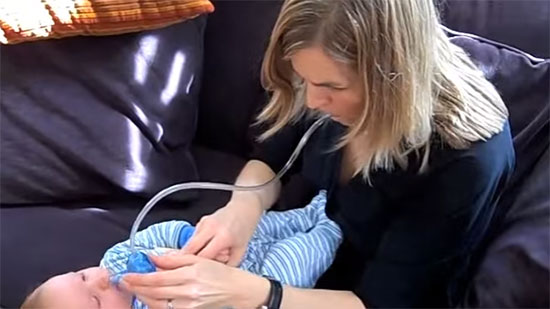
The most modern means are electronic aspirators. With their help, the process of suctioning mucus occurs in the most painless and fastest way. This device runs on batteries. The nozzle is inserted into the child's nostril, then you press a button, and the process of suctioning the mucus into the container occurs. Your baby won’t even have time to notice that something has happened.
Additional moisturizers
To moisturize our little noses, you can use the following products:
- 9% saline solution, which can be easily purchased at a pharmacy;
- drops based on a solution of sea water, intended specifically for infants. Such drugs are Aquamaris, Morenazal, Aqualor, Physiomer and other analogues.
- In addition, you can prepare the solution yourself at home. To do this, take a liter of boiled water and a teaspoon of sea or table salt.
Safety precautions
- When cleaning the spout, do not use regular ear swabs.
- Do not suck out mucus from the spout with your mouth, so as not to contribute to the transmission of germs.
- Do not put breast milk in your baby's nose if he has a runny nose. Not only will this not help, but it can also harm the baby. Breast milk contains bacteria that can make the situation worse.
- All spout cleaning products must be clean and dry.
- Do not insert the device too deep into the nose so as not to damage the mucous membrane.
- Carefully read the instructions for using a particular device.
- Before removing dried crusts, be sure to moisten them. Then their removal will be safe and simple.
- The process of cleaning the nose should be carried out when the baby is in a good mood and in a favorable environment.
Disease Prevention
It is easier to prevent any illness than to treat it later. To reduce the incidence of dry crusts in your baby, you need to monitor the humidity of the room. It would be a good idea to purchase a hygrometer and monitor the humidity level. For a baby, 50%-70% will be suitable. It would be correct to carry out wet cleaning every day or buy a special humidifier.
To avoid frequent runny noses, it is necessary to strengthen the baby’s immunity. You should also limit your child’s contact with people who have a cold.
When to see a doctor
- If a runny nose or stuffy nose lasts longer than a week and your actions do not make your baby feel better, consult a doctor.
- If you see that your child has difficulty breathing, consult a doctor.
- If a runny nose is accompanied by symptoms such as high fever, rash, swelling, difficulty breathing after clearing the nasal cavity, or severe crying, seek help from a specialist immediately.
Any young mother hears advice from her friends and relatives on how to clean a newborn’s nose. But practice turns out to be more difficult than theory. At first you may have some difficulties. But everything comes with experience. You will get the hang of doing this and will be able to choose a product and method of nose care that is right for you and your child.

